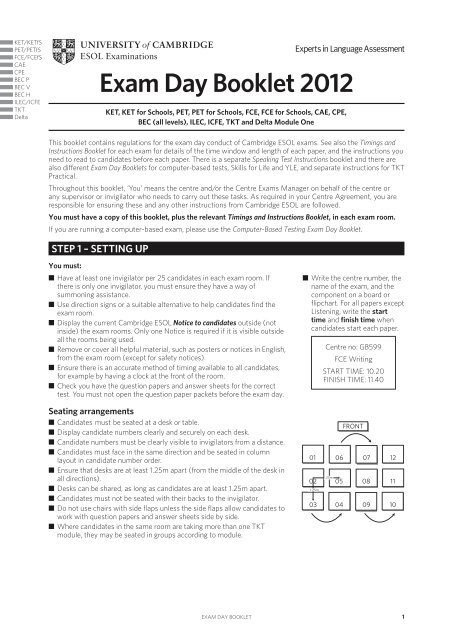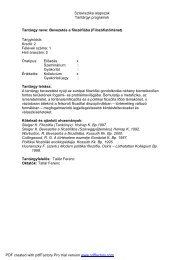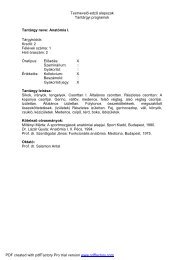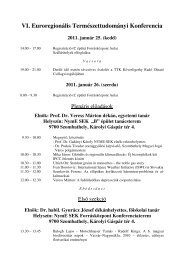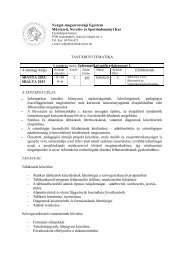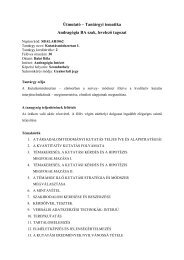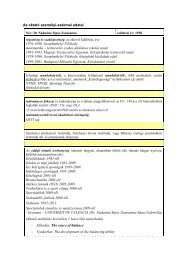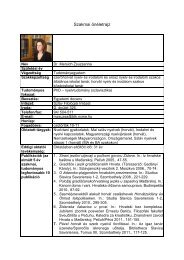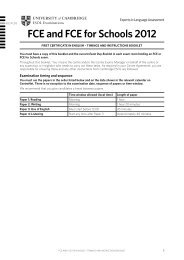Exam Day Booklet 2012 - NymE - SEK
Exam Day Booklet 2012 - NymE - SEK
Exam Day Booklet 2012 - NymE - SEK
You also want an ePaper? Increase the reach of your titles
YUMPU automatically turns print PDFs into web optimized ePapers that Google loves.
KET/KETfS<br />
PET/PETfS<br />
FCE/FCEfS<br />
CAE<br />
CPE<br />
BEC P<br />
BEC V<br />
BEC H<br />
ILEC/ICFE<br />
TKT<br />
Delta<br />
<strong>Exam</strong> <strong>Day</strong> <strong>Booklet</strong> <strong>2012</strong><br />
KET, KET for Schools, PET, PET for Schools, FCE, FCE for Schools, CAE, CPE,<br />
BEC (all levels), ILEC, ICFE, TKT and Delta Module One<br />
This booklet contains regulations for the exam day conduct of Cambridge ESOL exams. See also the Timings and<br />
Instructions <strong>Booklet</strong> for each exam for details of the time window and length of each paper, and the instructions you<br />
need to read to candidates before each paper. There is a separate Speaking Test Instructions booklet and there are<br />
also different <strong>Exam</strong> <strong>Day</strong> <strong>Booklet</strong>s for computer-based tests, Skills for Life and YLE, and separate instructions for TKT<br />
Practical.<br />
Throughout this booklet, ‘You’ means the centre and/or the Centre <strong>Exam</strong>s Manager on behalf of the centre or<br />
any supervisor or invigilator who needs to carry out these tasks. As required in your Centre Agreement, you are<br />
responsible for ensuring these and any other instructions from Cambridge ESOL are followed.<br />
You must have a copy of this booklet, plus the relevant Timings and Instructions <strong>Booklet</strong>, in each exam room.<br />
If you are running a computer-based exam, please use the Computer-Based Testing <strong>Exam</strong> <strong>Day</strong> <strong>Booklet</strong>.<br />
STEP 1 – SETTING UP<br />
You must:<br />
■ Have at least one invigilator per 25 candidates in each exam room. If<br />
there is only one invigilator, you must ensure they have a way of<br />
summoning assistance.<br />
■ Use direction signs or a suitable alternative to help candidates find the<br />
exam room.<br />
■ Display the current Cambridge ESOL Notice to candidates outside (not<br />
inside) the exam rooms. Only one Notice is required if it is visible outside<br />
all the rooms being used.<br />
■ Remove or cover all helpful material, such as posters or notices in English,<br />
from the exam room (except for safety notices).<br />
■ Ensure there is an accurate method of timing available to all candidates,<br />
for example by having a clock at the front of the room.<br />
■ Check you have the question papers and answer sheets for the correct<br />
test. You must not open the question paper packets before the exam day.<br />
Seating arrangements<br />
■ Candidates must be seated at a desk or table.<br />
■ Display candidate numbers clearly and securely on each desk.<br />
■ Candidate numbers must be clearly visible to invigilators from a distance.<br />
■ Candidates must face in the same direction and be seated in column<br />
layout in candidate number order.<br />
■ Ensure that desks are at least 1.25m apart (from the middle of the desk in<br />
all directions).<br />
■ Desks can be shared, as long as candidates are at least 1.25m apart.<br />
■ Candidates must not be seated with their backs to the invigilator.<br />
■ Do not use chairs with side flaps unless the side flaps allow candidates to<br />
work with question papers and answer sheets side by side.<br />
■ Where candidates in the same room are taking more than one TKT<br />
module, they may be seated in groups according to module.<br />
■ Write the centre number, the<br />
name of the exam, and the<br />
component on a board or<br />
flipchart. For all papers except<br />
Listening, write the start<br />
time and finish time when<br />
candidates start each paper.<br />
Centre no: GB599<br />
FCE Writing<br />
START TIME: 10.20<br />
FINISH TIME: 11.40<br />
FRONT<br />
01 06 07 12<br />
02 05 08 11<br />
1.25m<br />
1.25m<br />
03 04 09 10<br />
CBT<br />
YLE<br />
SfL<br />
EXAM DAY BOOKLET 1
<strong>Exam</strong> materials<br />
The exam materials have been checked by the centre on receipt. Make sure you have everything you need to run<br />
your exam today.<br />
Blank answer and mark sheets are provided for emergency use when an individually printed sheet is not available.<br />
Candidate<br />
Information<br />
Sheet (CIS)<br />
Reading &<br />
Writing<br />
Reading<br />
Writing<br />
Use of<br />
English<br />
Listening<br />
All modules TKT<br />
Paper 1<br />
Paper 2<br />
Provided by Cambridge ESOL<br />
Provided by you<br />
(the centre)<br />
ALL exams Candidate Information Sheets Soft pencils (B or HB),<br />
erasers<br />
KET/KET for Schools<br />
PET/PET for Schools<br />
BEC Preliminary<br />
FCE/FCE for Schools,<br />
CAE, CPE<br />
BEC Vantage<br />
BEC Higher<br />
ILEC, ICFE<br />
FCE/FCE for Schools,<br />
CAE, CPE<br />
BEC Vantage<br />
BEC Higher<br />
ILEC, ICFE<br />
FCE/FCE for Schools,<br />
CAE, CPE<br />
ALL exams (not<br />
applicable to TKT or<br />
Delta Module One)<br />
Delta Module One<br />
Question papers, personalised answer sheets*,<br />
attendance register, script return envelope, bar<br />
code label<br />
* For PET/PET for Schools Writing Part 3 and<br />
BEC Preliminary Writing Part 1 and 2, the<br />
answer sheets are packed in question paper<br />
envelopes with orange labels.<br />
Question paper booklets, attendance register,<br />
script return envelope, bar code label<br />
No answer sheets are provided. Candidates<br />
must write in the question paper booklets.<br />
Question papers, personalised answer sheets,<br />
attendance register, script return envelope, bar<br />
code label<br />
Question papers*, CDs*, individually printed<br />
answer sheets, attendance register, script return<br />
envelope, bar code label<br />
*Check you are using the correct version.<br />
Question papers, personalised answer sheets,<br />
attendance register, script return envelope,<br />
return label<br />
Question papers, answer booklets, attendance<br />
register, script return envelope, bar code label<br />
Soft pencils (B or HB),<br />
erasers<br />
Pens, rough paper<br />
Soft pencils (B or HB),<br />
erasers<br />
CPE only: rough paper<br />
Soft pencils (B or HB),<br />
erasers, CD player<br />
Soft pencils (B or HB),<br />
erasers, rough paper<br />
Authorised/unauthorised materials<br />
You must provide a designated area where candidates can store personal items during the exams (preferably<br />
outside the exam room). No smoking, eating or drinking is allowed in the exam room (except for water in a plastic<br />
bottle).<br />
Pens<br />
Authorised materials that candidates can have at<br />
their desk during the exam:<br />
Photo ID, pens, pencils, erasers, small pencil cases,<br />
water in a plastic bottle, medicine and confirmation<br />
of entry<br />
<strong>Exam</strong>ples of unauthorised materials for placing in the<br />
designated area:<br />
Mobile phones, cameras or any other electronic<br />
items, dictionaries, correction fluid/tape, etc., paper,<br />
bags, handbags, luggage<br />
✓<br />
✓<br />
✓<br />
✗<br />
✗<br />
✗<br />
All other materials must be placed in the designated<br />
area<br />
2<br />
EXAM DAY BOOKLET
Candidate Information Sheets<br />
We send you Candidate Information Sheets (CIS), pre-printed with candidate names and numbers. You are also<br />
given blank CIS for candidates whose pre-printed sheets are not available and for the Delta Module One exam.<br />
The Centre <strong>Exam</strong>s Manager can choose at what stage to ask candidates to complete the CIS on the exam day, and<br />
they must be completed by all candidates.<br />
■ Tell candidates that there are two sides to them.<br />
■ Tell candidates to keep CIS forms flat and not to write on the big black rectangles at the top and on the side.<br />
■ Collect CIS forms before starting a paper.<br />
STEP 2 – STARTING EACH TEST<br />
Test day photos<br />
Test day photos are mandatory for CAE, and may become mandatory for other exams throughout <strong>2012</strong>. You must<br />
take a photo of each candidate on the day of the written test or Speaking test. See the Test day photo guide for<br />
guidance.<br />
Checking candidates’ photo ID<br />
You must check the photo ID of each candidate for each paper. Candidates must be seated at their desks when<br />
the IDs are checked. When checking, you must check that the photo ID matches the candidate and that the name<br />
on the ID matches the name on the desk label/attendance register. In all cases, you must be confident about the<br />
candidate’s identity and have a suitable procedure for candidates who do not bring ID.<br />
READING, WRITING, USE OF ENGLISH<br />
You must check the candidates’ photo ID in the exam<br />
room for each paper. You can either do this before the<br />
start of the test, or within the first 15 minutes of each<br />
paper.<br />
LISTENING:<br />
You must check the candidates’ photo ID in the exam<br />
room before the paper starts.<br />
You must not allow any unauthorised people into the exam room. Inspectors will always provide proof of<br />
identity.<br />
You must repeat these actions at the beginning of each paper:<br />
1. Ensure that the mobile phones of all staff are switched off.<br />
2. Show candidates to the desk with their candidate number.<br />
Tell candidates:<br />
3. To switch off their mobile phones, including any alarms. Tell them that using the ‘vibrate’ mode is not<br />
acceptable as it may interfere with Listening test equipment.<br />
4. To switch off any electronic devices, including alarms on their watches.<br />
5. To put mobile phones and other unauthorised items in the designated area.<br />
6. That the use of any unauthorised electronic devices or mobile phones ringing will be treated as malpractice.<br />
7. They must not talk, copy, or keep or use unauthorised items or they may be disqualified.<br />
8. Not to open the question papers until they are told to do so.<br />
Then:<br />
9. Ensure that small pencil cases and documents required for identification have been checked for unauthorised<br />
items, and that pencil cases on desks are left open.<br />
10. Distribute answer sheets for the test that the candidates are about to take. Don’t give out answer sheets for<br />
subsequent tests.<br />
11. Write down any name corrections to be passed to the Centre <strong>Exam</strong>s Manager who will make any changes on<br />
the relevant Entries System.<br />
12. Open the question paper packets in front of the candidates and distribute them.<br />
13. Point out any important information about the paper (e.g. any errata).<br />
14. Tell candidates to look at the instructions on the front of the question paper and the separate answer sheet, if<br />
relevant.<br />
STEP 3 – READ OUT THE INSTRUCTIONS TO CANDIDATES<br />
15. Once the instructions for the paper have been read out from the relevant Timings & Instructions <strong>Booklet</strong>, write<br />
the start and finish times for the paper on the board and follow Steps 4 and 5 in this booklet.<br />
EXAM DAY BOOKLET 3
STEP 4 – DURING EACH TEST<br />
You must invigilate the exam and ensure that there is no malpractice. You also need to be alert to any candidates<br />
who need assistance (such as toilet breaks).<br />
INVIGILATING THE READING, WRITING, USE OF<br />
ENGLISH TESTS<br />
■ Invigilators must be alert at all times and regularly<br />
patrol the exam room.<br />
■ Look out for the possible use of any camera or<br />
electronic device.<br />
■ You must not do any other activity in the exam<br />
room, for example, reading a book or working on a<br />
laptop.<br />
INVIGILATING THE LISTENING TEST<br />
■ During the Listening test, you must ensure that<br />
invigilators have a good view of all candidates while<br />
the Listening test is being played.<br />
■ Look out for the possible use of any camera or<br />
electronic device.<br />
■ You must not do any other activity in the exam<br />
room, for example, reading a book or working on a<br />
laptop.<br />
■ You must not move around the room unless<br />
absolutely necessary as this can distract candidates<br />
and may affect their hearing of the test. However,<br />
you can use the final section of the test to move<br />
around and check candidates are transferring their<br />
answers to the answer sheets.<br />
Attendance registers<br />
Complete and sign the attendance register during each test.<br />
If a candidate is not on the attendance register, add their name and candidate number and tell the Centre <strong>Exam</strong>s<br />
Manager of this addition as soon as possible. If there is no space available on the attendance register, attach a<br />
note with the candidate’s name and candidate number. You must also mark Special Arrangements candidates on<br />
the attendance register.<br />
Absent candidates<br />
Mark a candidate’s absence on the attendance register in the attendance column and shade the relevant box on<br />
the candidate’s pre-printed answer sheet.<br />
Remove the absent candidate’s materials from the desk after allowing enough time for a late arrival.<br />
Note: You must never use an absent candidate’s answer sheet for another candidate.<br />
Room plans<br />
You must complete an accurate room plan during each test.<br />
The room plan must show the position of each candidate by candidate number, the direction they are facing, and<br />
the distance between their desks. Include the number and position of invigilators. For Listening tests, each room<br />
plan must also indicate the position of playback equipment and speakers, and of any pillars or other features<br />
which might affect the sound.<br />
Candidates who want to leave the room<br />
Candidates must not leave the room during the Listening test.<br />
For all other written papers a candidate can briefly leave and return to the exam room under supervision at any<br />
time (except during the final 10 minutes). For example, they must be escorted by a member of staff, have beforeand-after<br />
search of toilets, etc. If there is only one invigilator in a room, they must never leave the candidates<br />
unsupervised and must be able to summon assistance at any time during the exam.<br />
■ Tell the candidate to turn their question paper and answer sheet face down on their desk.<br />
■ Remind the candidate that they are still under exam conditions during the time they are out of the exam room.<br />
They must not communicate with anyone while outside the room.<br />
■ Make sure that the papers remain untouched until the candidate returns and resumes work.<br />
If a candidate has finished their test and wants to leave the room permanently, check the timings permitted in the<br />
Instructions to candidates section of the Timings and Instructions <strong>Booklet</strong> before allowing them to leave. Collect all<br />
question papers, answer sheets and any rough work before the candidate leaves the room. The candidate must<br />
remain seated while you collect the papers and they must leave the room quietly.<br />
Safeguarding the welfare of children and young people<br />
You are responsible for the safety and welfare of children and young people during the exam.<br />
4<br />
EXAM DAY BOOKLET
Incidents<br />
Malpractice<br />
Submit a Malpractice form and, if relevant, a Special Consideration form<br />
You must report anything unusual, such as suspicious behaviour of any candidates during the exam, to the Centre<br />
<strong>Exam</strong>s Manager.<br />
Some examples of malpractice:<br />
■ Talking<br />
■ Copying/collusion<br />
■ Using unauthorised materials,<br />
such as dictionaries or notes<br />
■ Using electronic devices<br />
■ Impersonation<br />
■ Disruptive behaviour<br />
■ Not following the instructions<br />
of exam staff<br />
■ Mobile phones ringing<br />
■ If you suspect misconduct:<br />
● Give a discreet but clear warning to the candidate that they will be<br />
reported.<br />
● Allow the candidate to complete any remaining tests.<br />
● Report the incident using a Malpractice form. Reports must contain<br />
specific and unambiguous details.<br />
● Do not ask candidates to write statements at the time.<br />
■ Candidates must not be disqualified from subsequent tests. However,<br />
in extreme circumstances you can exclude or expel a candidate from<br />
the exam room if the candidate’s continued presence would cause<br />
disruption to other candidates.<br />
■ If the candidate poses a threat to the health or safety of other candidates<br />
or exam staff, you can exclude the candidate from subsequent papers.<br />
The decision to disqualify must be left to Cambridge ESOL.<br />
Late arrivals<br />
Submit a Late Arrival form<br />
You must not allow late arrivals for Listening tests to enter once the test has started. However, for FCE, CAE and<br />
CPE, the supervisor can allow the candidate to take the test using a different test version later on the same day,<br />
provided they have not been in contact with candidates who have already taken the test.<br />
For other papers, you can allow late arrivals to enter (with the supervisor’s permission) if no other candidate has<br />
permanently left the room. You must give them the same instructions as other candidates and allow them the full<br />
time of the test.<br />
■ On the candidate’s question paper and answer sheet(s), indicate the point reached at the time when the paper<br />
was due to finish, with particular care being taken if questions have not been answered in sequence.<br />
■ If a candidate is late for a good reason (e.g. sudden illness or transport problems) and exam security has not<br />
been threatened, all the work completed by the candidate will be accepted by Cambridge ESOL.<br />
■ If a candidate is late because of carelessness (e.g. oversleeping or misreading the timetable) and exam security<br />
has not been threatened, the work completed within the exam times will be accepted by Cambridge ESOL.<br />
Special consideration<br />
Submit a Special Consideration form within two weeks of the exam day<br />
If something happens that you think may affect the performance of a candidate or a group of candidates, the<br />
Centre <strong>Exam</strong>s Manager must submit a Special Consideration form.<br />
For example, if any candidate is unwell during the exam, or if there is a loud noise during the Listening test,<br />
or problems with the Listening test equipment, submit this form to ensure that your candidates are not<br />
disadvantaged.<br />
Please consider whether the issue affects all the candidates in the room, a range of candidates in an area, or a<br />
single candidate.<br />
Emergencies<br />
Submit a Special Consideration form within two weeks of the exam day<br />
If there is an emergency, such as a fire alarm or bomb alert, follow the instructions below:<br />
■ Evacuate the exam room following the regulations of the venue.<br />
■ Leave the question papers and answer sheets in the exam room.<br />
■ Supervise the candidates as closely as possible to make sure they don’t talk to each other.<br />
■ After candidates have returned to the exam room and before the paper is resumed, mark on each candidate’s<br />
work where the interruption occurred.<br />
■ Note the time and length of the interruption.<br />
■ Write the new finish times on the board and allow candidates the full working time for the paper.<br />
EXAM DAY BOOKLET 5
STEP 5 – CONCLUDING EACH TEST<br />
READING, WRITING, USE OF ENGLISH<br />
■ Ten minutes before the end of the test, tell<br />
candidates there are 10 minutes left.<br />
■ If they are using an answer sheet, remind them that<br />
they must transfer their answers and make sure<br />
that they are doing so.<br />
■ For Writing, remind them to write within the grey<br />
lines in the spaces provided and make sure that<br />
they are doing so.<br />
■ Do not allow any candidate to leave the exam room<br />
in the final 10 minutes.<br />
■ Five minutes before the end of the test, tell<br />
candidates there are 5 minutes left.<br />
■ At the end of the test tell candidates to put their<br />
pens or pencils down immediately.<br />
LISTENING<br />
■ The test is divided into sections, and the recording<br />
on the CD is complete in itself, with all necessary<br />
pauses and instructions to candidates.<br />
■ At the end of the test tell candidates to put their<br />
pencils down immediately.<br />
■ Collect all question papers, answer sheets and rough work before candidates leave the exam room.<br />
■ Candidates must remain seated while you collect the papers.<br />
■ If a candidate does not transfer all their answers to the answer sheets in time, and you believe that there is a<br />
good reason, you must return the question paper with a report explaining the reasons for non-transfer. Any<br />
requests for Special Consideration because a candidate has not transferred their answers will not be accepted if<br />
submitted later.<br />
■ Pack materials according to the instructions given in Step 6.<br />
6<br />
EXAM DAY BOOKLET
STEP 6 – PACKING INSTRUCTIONS<br />
You must follow these instructions in order to enable prompt processing of results and to maintain the security of<br />
the materials.<br />
All materials must be returned or destroyed as listed in the table below. You must not keep anything to use for<br />
teaching or other purposes.<br />
For materials to be returned:<br />
■ Make sure materials for each test are packed in separate script return envelopes.<br />
■ Collate used question papers in candidate number order.<br />
■ Collate answer sheets in candidate number order.<br />
■ Split answer sheets into separate envelopes per packing code.<br />
See the table below for additional instructions.<br />
Candidate<br />
Information<br />
Sheet (CIS)<br />
Reading &<br />
Writing<br />
Reading &<br />
Writing<br />
Reading<br />
Writing<br />
Use of<br />
English<br />
ALL exams<br />
PET/PET for Schools<br />
BEC Preliminary<br />
KET/KET for Schools<br />
FCE/FCE for Schools<br />
CAE, CPE<br />
BEC Vantage<br />
BEC Higher<br />
ILEC, ICFE<br />
FCE/FCE for Schools<br />
CAE, CPE<br />
BEC Vantage<br />
BEC Higher<br />
ILEC, ICFE<br />
FCE/FCE for Schools<br />
CAE, CPE<br />
Listening ALL exams (except<br />
TKT and Delta<br />
Module One)<br />
All modules TKT<br />
Paper 1<br />
Paper 2<br />
Delta Module One<br />
Return in script return envelope<br />
Put used CIS forms in the original envelope or a<br />
similar A4 envelope marked CIS.<br />
Used and unused Reading answer sheets,<br />
used Writing answer sheets, room plan and<br />
attendance register.<br />
Collate answer sheets for Reading and<br />
Writing tests in separate piles.<br />
All answer sheets, room plan and attendance<br />
register.<br />
Used question papers, room plan and<br />
attendance register.<br />
Return all unused question papers in a separate<br />
envelope within the same package. Write<br />
‘Unused question papers’ on the envelope.<br />
All answer sheets, room plan and attendance<br />
register.<br />
Answer sheets, room plan and attendance<br />
register.<br />
Used question papers, answer sheets, room<br />
plan and attendance register.<br />
Do not insert answer sheets into question<br />
papers, create a separate pile.<br />
Return all unused question papers in a separate<br />
envelope within the same package. Write<br />
‘Unused question papers’ on the envelope.<br />
Answer booklets, room plan and attendance<br />
register.<br />
Destroy securely or return<br />
in a separate envelope<br />
within the same package<br />
Unused CIS forms.<br />
All question papers.<br />
Unused Writing answer<br />
sheets.<br />
All question papers.<br />
Securely destroy rough<br />
paper.<br />
All question papers.<br />
Securely destroy rough<br />
paper (CPE).<br />
All question papers.<br />
All CDs.<br />
Securely destroy rough<br />
paper.<br />
All question papers.<br />
■ Seal the materials to be returned in the script return envelope immediately and attach the bar code label.<br />
● If your Centre <strong>Exam</strong>s Manager wishes to double-check that materials are packed correctly, seal the materials<br />
in a similar A4 envelope in the presence of a witness. You must then provide two signatures across the seal<br />
and give the envelope to the Centre <strong>Exam</strong>s Manager.<br />
■ <strong>Exam</strong> materials must never be stored unsealed.<br />
■ Give the envelope to the person responsible for keeping it in a safe place and despatching it.<br />
EXAM DAY BOOKLET 7
KET/KETfS<br />
PET/PETfS<br />
FCE/FCEfS<br />
CAE<br />
CPE<br />
BEC P<br />
BEC V<br />
BEC H<br />
ILEC/ICFE<br />
TKT<br />
Delta<br />
Returning other materials to Cambridge ESOL<br />
Forms<br />
You must send all Special Consideration, Malpractice and Late Arrival forms directly to the <strong>Exam</strong>s Processing Unit<br />
(Special Circumstances) whose contact details are included on each form. Do not send them back in the same box<br />
as the exam scripts.<br />
Materials for absent candidates and unused reserve entries<br />
Answer sheets<br />
■ Mark the candidate as absent on the answer sheet.<br />
■ Add the answer sheet(s) in sequence with the other candidates’ answer sheets in the script return envelope.<br />
Question papers<br />
■ Refer to the table in Step 6 and follow the relevant instructions for unused question papers.<br />
For PET, PET for Schools and BEC Preliminary<br />
■ Mark the candidate as absent on the Reading answer sheet.<br />
■ Add the Reading answer sheets in sequence with the other candidates’ answer sheets in the script return<br />
envelope.<br />
■ For unused Writing answer sheets, you can destroy them securely or return them in a separate envelope. Write<br />
‘Unused Writing answer sheets’ on the envelope.<br />
Materials for candidates who arrive late<br />
■ Include the question paper and answer sheet(s) in the script return envelope in sequence with the other<br />
candidates’ work.<br />
■ The Centre <strong>Exam</strong>s Manager must send the completed Late Arrival form separately to the <strong>Exam</strong>s Processing<br />
Unit (Special Circumstances), including a Special Consideration form if necessary.<br />
Materials for candidates with special arrangements<br />
Administrative special arrangements only (e.g. extra time)<br />
■ Include the candidates’ materials with the other candidates’ materials.<br />
Modified materials<br />
■ Put the candidate’s answers for each paper in a separate A4 envelope, including any other materials, such as<br />
Instructions to supervisors booklets and CDs.<br />
■ Write the candidate details on the envelope.<br />
■ Add the envelope in sequence with the other candidate materials in the correct script return envelope.<br />
■ Write ‘Candidate with special arrangements’ on the outside of the script return envelope.<br />
■ Despatch the script return envelope to Cambridge ESOL in the usual way.<br />
■ If you need to transcribe the candidate answers, please refer to The writing of answers section in the Special<br />
Requirements <strong>Booklet</strong>. In the case of blind candidates, it is the responsibility of the centre to arrange for the<br />
transcribing of Braille answers, before returning the scripts.<br />
CBT<br />
YLE<br />
SfL<br />
© UCLES 2011 EMC/7826/1Y10<br />
NOT FOR RESALE<br />
*8904801371*<br />
8<br />
EXAM DAY BOOKLET


